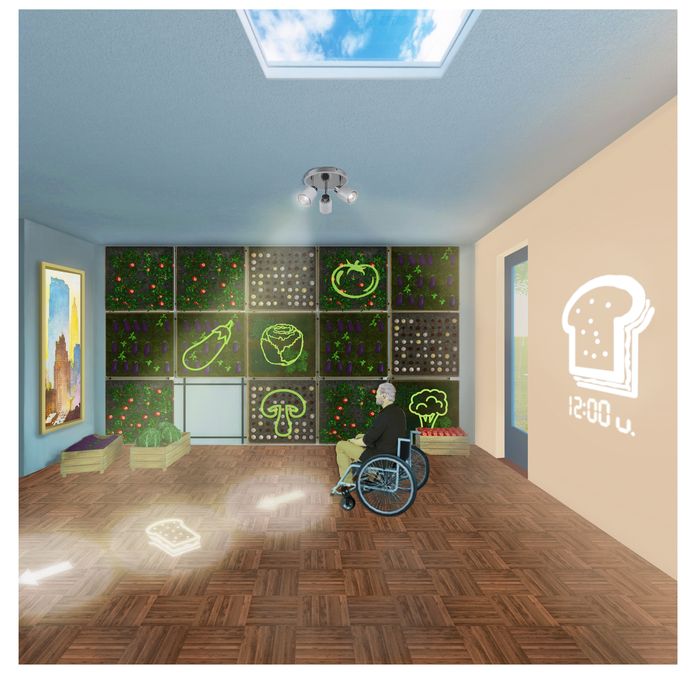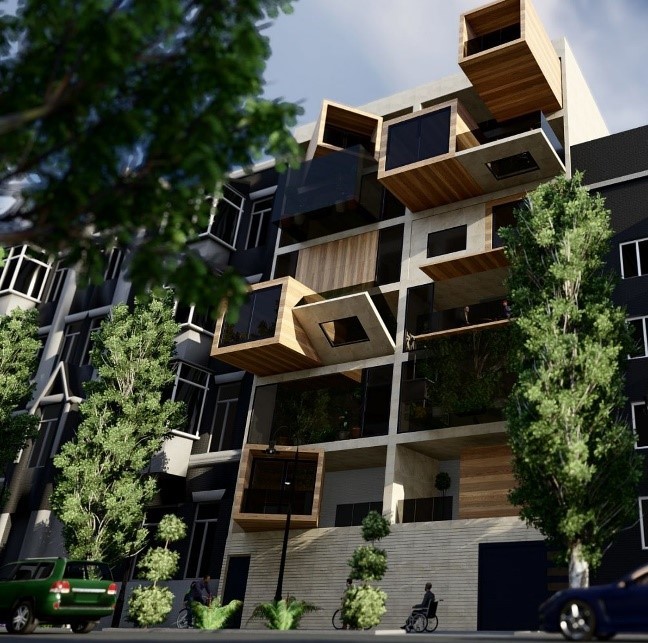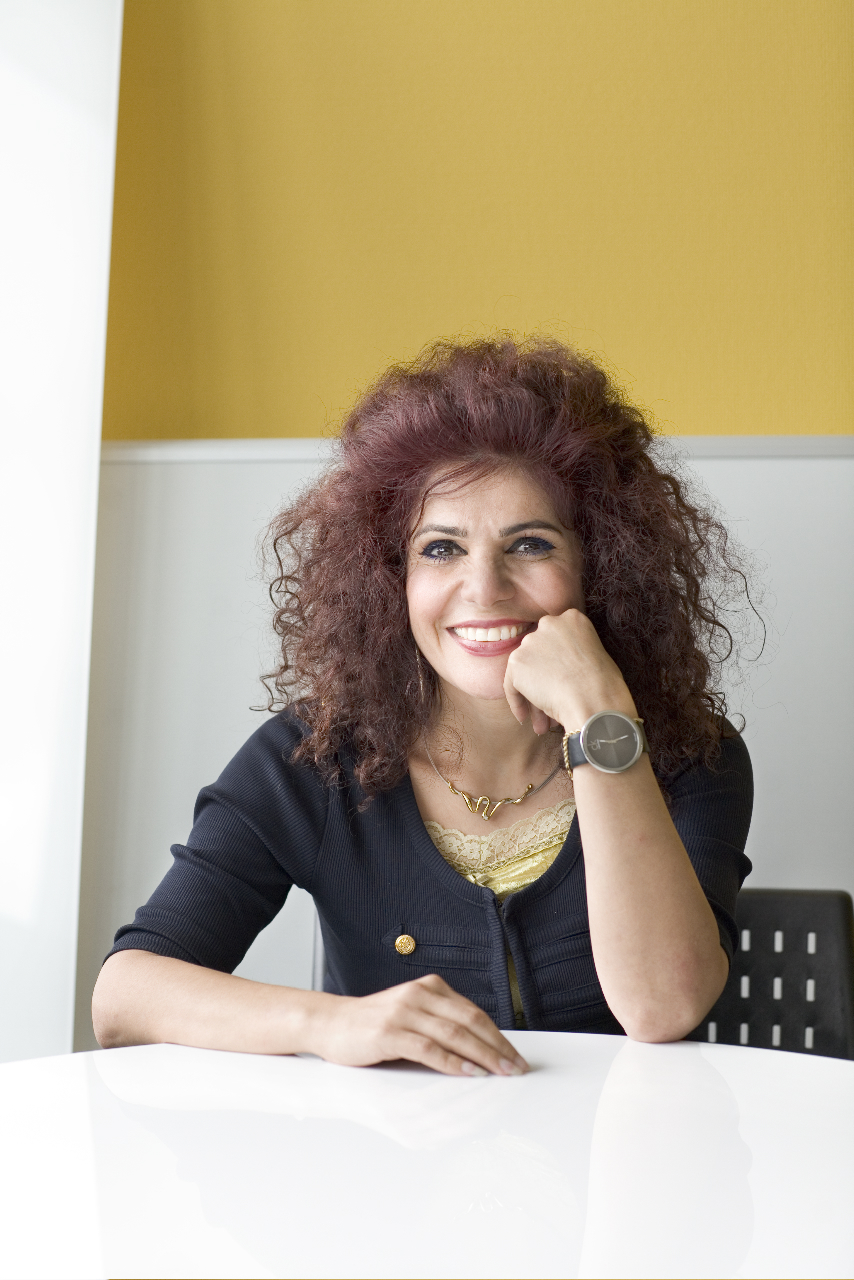HOW AI IN THE BUILT ENVIRONMENT CAN SHAPE NEW HOUSING TYPOLOGIES
Editie: 29 - Artificial Intelligence in the Built Environment
Published on: 11 april 2022
On Monday the 28th of February, the SERVICE editors held an interview with Masi Mohammadi, full professor at the Eindhoven University of Technology and, since 2016, head of chair Smart Architectural Technologies. In this interview, the possibilities of Artficial Intelligence (AI) in housing and communities will be explored, as well as the necessary shifts in decision making in order to optimally fulfill the potential of AI.
Artificial Intelligence as a strengthening factor
The use of AI within the built environment revolves around the envisioning of the new way of life now and in the future. It deals with bringing back the socio-economic developments into society itself, while embedding technological innovations in the DNA of the built environment. Dwellings and communities must be built, letting residents participate in activities they wish to do. Technology should not only empower people, but empower people in a way that they can more quickly flourish and express themselves.
Right now prof.dr.ir. M. Mohammadi, the chair of Smart Architectural Technologies, deals with empowering people that belong to the more vulnerable groups of society, like older citizens, or people with a lower socio-economic status. The questions she asks, deal with how building designers empower those people, how can we assist them and compensate their physical or psychological restrictions so that it not only benefits society, but more importantly themselves. This is not only looking at the impairments these individuals possess, but also looking at the capabilities they still have. Someone that suffers from psychological sickness for example, might still be physically able to go outside for a walk. In such situations, how can we, using AI, aid those people, so they can still walk around independently? Another important topic is about strengthening social cohesion in a community, and stimulating the interaction and cooperation between residents. Using AI can then help shift the purpose of dwellings. Not only do they need to shelter and provide security, but they can also help us understand the ways of living of the residents, thus helping us think of solutions, to help raise our capabilities and compensate the flaws of decision makers The key issues that AI helps us with are the importance of user-centeredness and improving both physical and mental health & well-being, which ultimately will raise the overall quality of life.
Ground breaking developments in one field must also be translated into developments in another. A technology is only as strong as its application in real life. For AI in the built environment this means that the concepts and ideas of one field (e.g. technology) must be translated into new architectural concepts, and ultimately also into new housing typologies. However, it is not only important to create entirely new typologies, but also to perhaps re-use existing types or to extend the capabilities of existing types.
Smart facades, homes, buildings and environments
In the chair of Smart Architectural Technologies not only new strategies and typologies are thought of, they are also tested in practice, and when successful, applied to real dwellings. If the right balance between technology and human-centeredness is found, the built environment is able to become more dynamic and interactive. It can then be not only passive interactively used, but also active interactively. A well-illustrated example of what is meant with this can be found in urban situations. Nowadays, due to rising populations, new ways of living and migration developments, the demand for housing is growing rapidly, resulting in more compact urban living. However, such urban living does not always fulfil the requirements of all residents. Imagine as a student with a room that during the day has the perfect size. However, when the student wants to throw a party in the evening, they experience a serious lack of space. What if in such scenarios one might be able to, quickly, change the façade of your apartment in a way that transforms the balcony into an additional room. This concept is one of the most prominent examples of what Mohammadi is working on: a changeable home that allows, for example, a balcony to shrink or expand based on the need of its user. In such a concept, the AI-based dwelling itself functions as a robot. A robot namely, is something which is smart and can move, and therefore can also consist of something larger.

Figure 1. Emphatic home.
Another example that has shifted forwards in Mohammadi’s vision is that of a dwelling, being the ‘carer’ for older people that still live in their own home. This (empathic) dwelling may support for example older people coping with the earliest stages of dementia. These people do not have a constant eye and aid to look after them. What if this aid can be provided for by their dwellings itself. For example, walls that can remind them to eat their lunch through vision, smell and sound. Floors with luminescent arrows can help them navigate through their homes. Vertical gardens can stimulate their fifth sense and help them stay active, eat healthy and maintain their hobby (gardening) while remaining in their home. This ‘caring’ home has been tested and applied in real-life projects of some care institutions and corporations. Not only can this concept be applied in new construction, but also in existing (terraced) housing. An application on a larger scale can then result in more seniors living independently in their own home, reducing the pressure on caring facilities.
On a larger scale, AI can be used to provide solutions for revolving homes and buildings. Imagine on a sunny day, someone in poor physical shape, wants to sit in the sun while her apartment is facing north. This person is not able to move into the sun, but what if her dwelling is able to do so? Examples of revolving homes already exist for the superrich, yet it needs to be optimized to apply on a larger scale. However, what if she lives in an apartment building, then the other side of the building will rotate into the shadow. In such situations, Mohammadi proposes to design buildings that consist of two boxes, allowing all sides of the building, and all apartments, to rotate in such a way that they receive sunlight. If someone lives on the ground floor as well, why can the façade not fold open as it were, making the apartment into a terrace, reducing the effort necessary to be outside?

Figure 2. Home as a robot.
A final example of AI that Mohammadi is working on can be found in an even larger scale. At the Slimme Wijk in Waalre, the Netherlands. Here, she aims to build a community for residents with a lower socio-economic status, in which they are (physically) able to grow old happily. The goal is that the neighbourhood itself can help its residents, for example by stimulating caring communities or by placing digital boundaries in the urban environment. Such an urban environment can in itself, also fall into a new typology of neighbourhoods, just as the buildings within it. However, the cooperation between a smart, ‘caring’ home and a healthy, smart neighbourhood is still in the development phase. The potential of smart homes is something that moves forward only in small steps, with a lot of uncertainty.
Shifts in thinking
The most important necessary change perhaps resembles human cognitive behaviour. At the moment, industrial, flexible dependable (IFD) buildings exist. However, none of those words concern persons, the individual actually using them. Building is about how different components sequence each other. Now, society would benefit from a shift to not only how do they sequence each other, but rather to how do they sequence each other concerning the needs and opportunities from the individual. Furthermore, the introduction of AI concepts into building (blocks) and neighbourhoods also requires a detailed and intensive planning. The idea of a rotating building seems ideal, but how is it planned to rotate it and in what exact angle, as this depends on not one, but many individuals. In such situations, the building cannot only be seen as purely functional, but also as an attraction point, a gadget. At the moment, the purely functional aspect is too dominant. The task now is to develop lots of housing, and the answer to this is to plant the entire country full with high-rise residential buildings. However, there still might be many other ideas that are not used. Bright heads might come up with solutions to problems with great potential, but great potential is worthless if it is not accepted and used by society. Also in AI, in the past years a lot of experiments have been conducted regarding the different options and potentials of technology in the built environment. Currently, a lot of them have been tested and verified, and now is the time to harvest. The great ideas should be adopted in real life. This has been done increasingly in the past years, however it should be done in the right way that is fitting for all, which is the grand difference between appraisal and application: in order to do so, a shift in thinking is necessary, a shift to societal responsible building.
If such a change in thinking does not occur in the next years, it might become more difficult to apply and harvest the qualities of AI in the built environment. This can for example be seen in one of the Living Labs that Mohammadi is working with. People from the ‘real world’ and students often sit around the table. The experiences that occur are cornerstones for the development of future building projects, and expand the horizons of all parties involved. Students get the opportunities to learn more about the practical implications and shortcomings, while the professionals can get inspired by the students’ forward-looking and open-minded thoughts. In debates that occur, there is often a great difference in priorities: for example a project developer aims to quickly finish the project to optimize yield, while the students continuously concern themselves with the societal benefit of the project. Such an opposition can result in serious debates, often even leading to verbal fights between the two parties. Then it is important for the new generation to stand their ground, re-educating the previous generations. If the existing working generations are not re-educated, it might be hard, or even impossible, for students with great knowledge of AI to be successful after their studies, since not many companies and projects see the value of AI and are not eager to adopt the inventions. This is especially important for the built environment, as this sector is deemed to lack behind other sectors in regard to the adoption of technology and inventions.
For AI in the built environment to become the norm, Mohammadi sees two critical components. First, it must be acknowledged that becoming the new norm does not happen in a few years. Generation upon generation to follow must believe in the strength, social- and technical capabilities of AI. Only in the long term, the results and benefits can be seen and seized. Secondly, she recalls the concept of breaking-the-dam. In order to break the dam, it only needs one hole. Once that hole has been made, the water will flow out in an exponential rate. Breaking it in the first place, is the stage of AI society is in now. In order to do so, AI innovators must keep on knocking on the dam, they must continuously try and convince others of the potential of AI. Mohammadi is positive and believes that eventually, the dam will break. She recollects her time as a graduate, where nobody thought that the necessity of AI today would be so high. However, sectors must not dive in blindly in the concept of AI, as these risks might be just as high as not using AI at all. She opts for a gradual approach, which requires people that see the potential, that correct information to become widespread, that the necessity will be seen and that the capacity of the built environment can be visualized. The optimism she draws from the large scale application of BIM, and the rising application of the Digital Twin. However, these two applied practices concern the preparation of the building process. Why can the building process itself not become smarter? Why is digitalization in one phase of the building process already embraced, but not the other?
Finally, Mohammadi attaches great value on students and future generations. The application of AI and the general state of the built environment is in their hands. They must believe in the capacities of AI, and not merely are interested in making gadgets, -to increase the attractivity. New generations and students must demand of teachers, and the overall current professionals, to really consider AI. Students should not be followers, but shaping the education programs of the future, and thus reshape the future of the built environment and society.
References
Brainport Eindhoven. (2020). Wonen in een robot, ‘een huis moet zich letterlijk aanpassen aan de bewoners’. Retrieved from: https://brainporteindhoven.com/nl/nieuws/wonen-in-een-robot-een-huis-moet-zich-letterlijk-aanpassen-aan-de-bewoners
Empathische Woning. (n.d.). DEEL academy. Retrieved from: https://www.empathischewoning.nl/
Empathische Woning. (2020a). Digitale snufjes in ‘slim huis’ helpen mensen met dementie. Retrieved from: https://www.empathischewoning.nl/nieuws/digitale-snufjes-in-slim-huis-helpen-mensen-met-dementie
Empathische Woning. (2020b). Slim huis TU Eindhoven werkt als mantelzorger voor dementerende. Retrieved from: https://www.empathischewoning.nl/nieuws/slim-huis-tueindhoven-werkt-als-mantelzorger-voor-dementie
Empathische Woning. (2020c.). Edible Wall. Retrieved from: https://www.empathischewoning.nl/projecten/edible-wall/
Mail the editors
